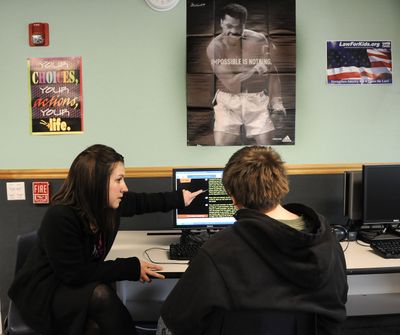Internet changes course of learning
More K-12 students drawn to flexibility, options of online education

Cassie Tompkins wanted her children to receive a quality education, but the Seattle resident also wanted Bailey and Brannon to pursue their blossoming acting careers.
“After months of research, what we found at East Valley (Online School) meets both of these,” Tompkins said of a program launched this year by East Valley School District. Bailey, a fourth-grader, and Brannon, a high school sophomore, were enrolled in the district’s new program earlier this year.
Online education is quickly becoming a popular option for K-12 students nationwide for a variety of reasons: highly motivated students trying to add on one more course; students who need to make up a failed class; socially awkward kids who work better in an alternative environment; or students like the Tompkinses who are unable to attend traditional classes.
Some studies suggest that in 10 years, 50 percent of learning will be done online.
Online learning isn’t for everyone, said Judy Margrath-Huge, director of a new division in the Washington Office of Superintendent of Public Instruction devoted to digital learning. “This is not a silver bullet answer for every student. This is just another option,” she said.
But during the 2008-’09 school year, 14,126 of Washington’s secondary students were enrolled in one or more online courses for credit, and of those, 3,810 were taking all of their courses online, state officials said.
Idaho is also seeing growing interest in online learning. An estimated 15,400 students are currently enrolled in online courses.
“We just started the Idaho Education Network, which will connect every district in the state,” said Melissa McGrath, spokeswoman for the Idaho State Department of Education. “Every high school will have at least one classroom set up to be a virtual classroom. (Students) will be able to take classes from other districts or even community colleges.”
East Valley’s Online School, the newest in the region, “is different than other online programs in that our (full-time online) students can enroll in two or three courses at a time,” said Barbara Cruse, the online school’s principal. That’s different than the usual course load of six online classes at a time.
“They concentrate their 25 hours per week on those courses. That allows them to finish within four to six weeks,” and move on to the next courses, Cruse said.
Tompkins said her children often travel to Los Angeles for acting jobs – sometimes at just a moment’s notice – so they need flexibility that traditional classrooms can’t provide.
The East Valley Online School comes under the umbrella of the district’s Washington Academy of Arts and Technology, which also includes multiple online education options, including GED studies, support for home-schooled kids, and programs for alternative students and teen parents.
East Valley is one of only two districts in the state that currently offer classes to all K-12 students. Spokane Public Schools offers online learning, but its program is restricted to grades nine through 12.
East Valley’s curriculum is provided by a company called Aventa, and the district provides the teachers. That model is one of three approved options in Washington.
The other two are for school districts to create the curriculum and offer it to students inside and outside the district, as Spokane Public Schools has done; or for a private company to create the course and supply the teachers, state officials said.
Students who enroll in East Valley Online School can live anywhere in the state, yet they are included in the district’s enrollment numbers.
That’s not the case with Spokane Public Schools, which can provide online courses to other districts for a fee, as well as offer courses to students from both inside and outside the district.
Legislation enacted this summer in Washington is designed to monitor the state’s growing online learning options, and included the creation of OSPI’s Digital Learning division.
The division is designed to hold online education providers – both school districts and for-profit companies – accountable for content and student success, said Margrath-Huge, the director.
The division is studying the development of online learning during the 2008-’09 school year and will submit a report to the Legislature in December.
So far, the division has found 20 or 30 online school programs statewide. Some serve multiple grade levels and many students; others just offer classes to the kids in their district, Margrath-Huge said.
The new legislation requires that all providers receive approval through an application process. Currently, only five online providers have been approved, officials said. The remainder, including the company East Valley chose, will have to go through the application process.